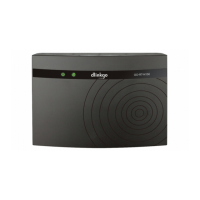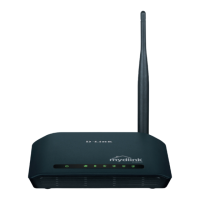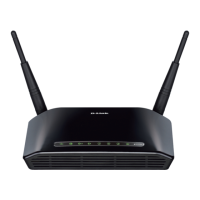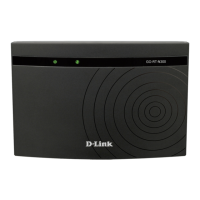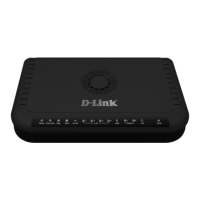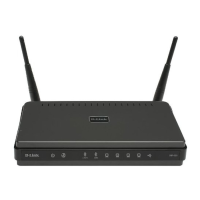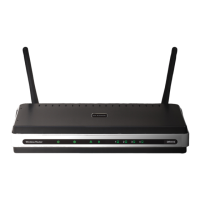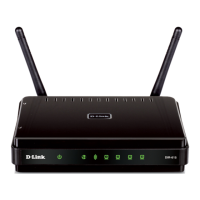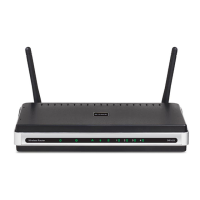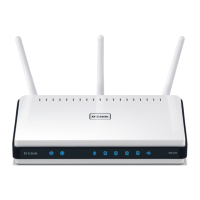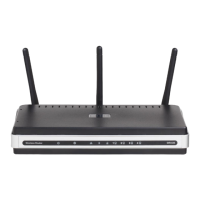Do you have a question about the D-Link N150 and is the answer not in the manual?
Lists the items included in the product package.
Details the necessary hardware and software for the device.
Provides an overview of the DHP-1220AV and its capabilities.
Highlights the key capabilities and benefits of the DHP-1220AV.
Describes the physical components and ports of the device.
Explains the function of the device's buttons.
Describes the status indicators (LEDs) on the device.
Provides guidelines for optimizing wireless range and performance.
Details the physical setup steps for the Powerline network.
Advises on optimal placement and electrical considerations for Powerline devices.
Outlines crucial safety instructions for using the device.
Introduces the web-based utility for device configuration.
Explains how to configure the device's Internet connection settings.
Details manual configuration of static IP address settings.
Describes PPPoE connection setup using username and password.
Guides users through a step-by-step network setup process.
Covers customization of wireless network name, channel, and security.
Allows configuration of local network IP and DHCP settings.
Explains how to configure Powerline network settings and power saving.
Details how to set up port forwarding rules for network services.
Explains how to use MAC filtering to control network access.
Describes how to block or allow access to specific websites.
Covers advanced wireless settings like transmit power and WMM.
Explains advanced network features like UPnP and WAN ping.
Allows changing administrator password and enabling remote management.
Covers configuring the device's time zone and date settings.
Provides options for saving, loading, and restoring device settings.
Explains how to upgrade the device's firmware.
Details how to set up Dynamic DNS for hosting servers.
Helps diagnose network connectivity problems using ping tests.
Displays current device information, LAN, and wireless status.
Shows event logs and activities occurring on the device.
Displays traffic statistics for LAN and wireless connections.
Lists current wireless clients connected to the router.
Provides links to further information on firmware sections.
Explains how to connect devices using the Wi-Fi Protected Setup (WPS) button.
Guides Windows 8 users on connecting with WPA/WPA2 security.
Guides Windows 7 users on connecting with WPA/WPA2 security.
Guides Windows Vista users on connecting with WPA/WPA2 security.
Guides Windows XP users on connecting with WPA/WPA2 security.
Solves issues related to accessing the device's web configuration interface.
Provides steps to reset the router if the password is forgotten.
Addresses issues with connecting to specific sites or sending emails.
Provides an introduction to D-Link wireless products and their benefits.
Explains the fundamental concept of wireless or Wi-Fi technology.
Highlights D-Link's position and offerings in the wireless market.
Describes the mechanism of wireless data transmission.
Details the function and reach of Wireless Local Area Networks.
Explains Wireless Personal Area Networks and Bluetooth technology.
Discusses the adoption and use cases of wireless technology.
Identifies common locations and scenarios where wireless is utilized.
Offers practical advice for installing a wireless network.
Advises on optimal placement for router/access point for best performance.
Provides methods to reduce interference for wireless signals.
Recommends securing the wireless network using WPA or WEP.
Explains the two primary modes of wireless networking: Infrastructure and Ad-Hoc.
Introduces fundamental networking concepts for D-Link adapters.
Guides users on how to verify their IP address using command prompt.
Details the process of manually assigning a static IP address.
Lists the technical standards, interfaces, and physical attributes of the device.
Lists the items included in the product package.
Details the necessary hardware and software for the device.
Provides an overview of the DHP-1220AV and its capabilities.
Highlights the key capabilities and benefits of the DHP-1220AV.
Describes the physical components and ports of the device.
Explains the function of the device's buttons.
Describes the status indicators (LEDs) on the device.
Provides guidelines for optimizing wireless range and performance.
Details the physical setup steps for the Powerline network.
Advises on optimal placement and electrical considerations for Powerline devices.
Outlines crucial safety instructions for using the device.
Introduces the web-based utility for device configuration.
Explains how to configure the device's Internet connection settings.
Details manual configuration of static IP address settings.
Describes PPPoE connection setup using username and password.
Guides users through a step-by-step network setup process.
Covers customization of wireless network name, channel, and security.
Allows configuration of local network IP and DHCP settings.
Explains how to configure Powerline network settings and power saving.
Details how to set up port forwarding rules for network services.
Explains how to use MAC filtering to control network access.
Describes how to block or allow access to specific websites.
Covers advanced wireless settings like transmit power and WMM.
Explains advanced network features like UPnP and WAN ping.
Allows changing administrator password and enabling remote management.
Covers configuring the device's time zone and date settings.
Provides options for saving, loading, and restoring device settings.
Explains how to upgrade the device's firmware.
Details how to set up Dynamic DNS for hosting servers.
Helps diagnose network connectivity problems using ping tests.
Displays current device information, LAN, and wireless status.
Shows event logs and activities occurring on the device.
Displays traffic statistics for LAN and wireless connections.
Lists current wireless clients connected to the router.
Provides links to further information on firmware sections.
Explains how to connect devices using the Wi-Fi Protected Setup (WPS) button.
Guides Windows 8 users on connecting with WPA/WPA2 security.
Guides Windows 7 users on connecting with WPA/WPA2 security.
Guides Windows Vista users on connecting with WPA/WPA2 security.
Guides Windows XP users on connecting with WPA/WPA2 security.
Solves issues related to accessing the device's web configuration interface.
Provides steps to reset the router if the password is forgotten.
Addresses issues with connecting to specific sites or sending emails.
Provides an introduction to D-Link wireless products and their benefits.
Explains the fundamental concept of wireless or Wi-Fi technology.
Highlights D-Link's position and offerings in the wireless market.
Describes the mechanism of wireless data transmission.
Details the function and reach of Wireless Local Area Networks.
Explains Wireless Personal Area Networks and Bluetooth technology.
Discusses the adoption and use cases of wireless technology.
Identifies common locations and scenarios where wireless is utilized.
Offers practical advice for installing a wireless network.
Advises on optimal placement for router/access point for best performance.
Provides methods to reduce interference for wireless signals.
Recommends securing the wireless network using WPA or WEP.
Explains the two primary modes of wireless networking: Infrastructure and Ad-Hoc.
Introduces fundamental networking concepts for D-Link adapters.
Guides users on how to verify their IP address using command prompt.
Details the process of manually assigning a static IP address.
Lists the technical standards, interfaces, and physical attributes of the device.
| AC input | 100 - 240 V AC, 50/60 Hz |
|---|---|
| ethernet | 10/100 Mbps |
| WLAN | Up to 150 Mbps |
| powerline | Up to 200 Mbps |
| frequency range | 2.4 GHz to 2.497 GHz |
| operating temperature | 0 to 40 °C (32 to 104 °F) |
| storage temperature | -20 to 65 °C (-4 to 149 °F) |
| humidity operation | 10% to 90% non-condensing |
| humidity storage | 5% to 95% non-condensing |
| dimensions | 73 x 58 x 37 mm (2.87 x 2.28 x 1.46 inches) |
|---|---|
| weight | 96 grams (3.39 ounces) |
